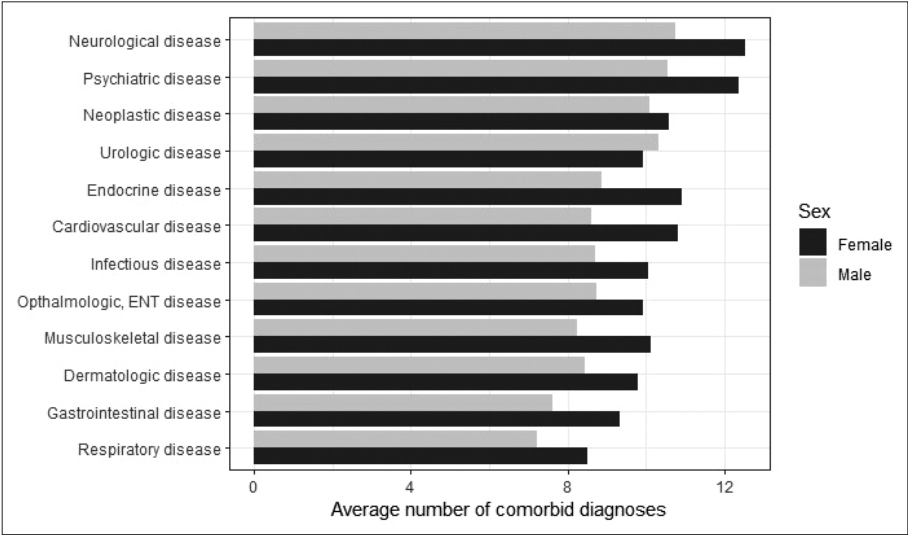7. Yang C, Zhong X, Zhou H, Wu Z, Zhang M, Ning Y. Physical Comorbidities are independently associated with higher rates of psychiatric readmission in a Chinese Han population. Neuropsychiatr Dis Treat 2020;16:2073-2082.


10. Firth J, Siddiqi N, Koyanagi A, Siskind D, Rosenbaum S, Galletly C, et al. The Lancet Psychiatry Commission: a blueprint for protecting physical health in people with mental illness. Lancet Psychiatry 2019;6:675-712.


14. Crawford MJ, Jayakumar S, Lemmey SJ, Zalewska K, Patel MX, Cooper SJ, et al. Assessment and treatment of physical health problems among people with schizophrenia: national cross-sectional study. Br J Psychiatry 2014;205:473-477.


16. Katon WJ. Clinical and health services relationships between major depression, depressive symptoms, and general medical illness. Biol Psychiatry 2003;54:216-226.


17. Vancampfort D, Koyanagi A, Hallgren M, Probst M, Stubbs B. The relationship between chronic physical conditions, multimorbidity and anxiety in the general population: a global perspective across 42 countries. Gen Hosp Psychiatry 2017;45:1-6.


18. Romain AJ, Marleau J, Baillot A. Impact of obesity and mood disorders on physical comorbidities, psychological well-being, health behaviours and use of health services. J Affect Disord 2018;225:381-388.


20. Klabunde CN, Warren JL, Legler JM. Assessing comorbidity using claims data: an overview. Med Care 2002;40(8 Suppl):IV-26-35

21. Klabunde CN, Legler JM, Warren JL, Baldwin LM, Schrag D. A refined comorbidity measurement algorithm for claims-based studies of breast, prostate, colorectal, and lung cancer patients. Ann Epidemiol 2007;17:584-590.


26. Kim JH, Son KY, Shin DW, Kim SH, Yun JW, Shin JH, et al. Network analysis of human diseases using Korean nationwide claims data. J Biomed Inform 2016;61:276-282.


27. Tabarés-Seisdedos R, Gómez-Beneyto M, Haro JM, González-Pinto A, Vieta E. The importance of negative comorbidity. J Clin Psychiatry 2009;70:1191-1192.


31. Cramer AO, Waldorp LJ, van der Maas HL, Borsboom D. Comorbidity: a network perspective. Behav Brain Sci 2010;33:137-150.


35. García Del Valle EP, Lagunes García G, Prieto Santamaría L, Zanin M, Menasalvas Ruiz E, Rodríguez-González A. Disease networks and their contribution to disease understanding: a review of their evolution, techniques and data sources. J Biomed Inform 2019;94:103206


36. Ni P, Wang J, Zhong P, Li Y, Wu FX, Pan Y. Constructing disease similarity networks based on disease module theory. IEEE/ACM Trans Comput Biol Bioinform 2020;17:906-915.


37. Nocaj A, Ortmann M, Brandes U. Untangling the hairballs of multicentered, small-world online social media networks. J Graph Algorithms Appl 2015;19:595-618.

39. Ehlert U, Gaab J, Heinrichs M. Psychoneuroendocrinological contributions to the etiology of depression, posttraumatic stress disorder, and stress-related bodily disorders: the role of the hypothalamus-pituitaryadrenal axis. Biol Psychol 2001;57:141-152.


40. Cameron OG, Abelson JL, Young EA. Anxious and depressive disorders and their comorbidity: effect on central nervous system noradrenergic function. Biol Psychiatry 2004;56:875-883.


41. Bremmer MA, Beekman AT, Deeg DJ, Penninx BW, Dik MG, Hack CE, et al. Inflammatory markers in late-life depression: results from a population-based study. J Affect Disord 2008;106:249-255.


43. Larson SL, Clark MR, Eaton WW. Depressive disorder as a long-term antecedent risk factor for incident back pain: a 13-year follow-up study from the Baltimore Epidemiological Catchment Area sample. Psychol Med 2004;34:211-219.


46. Köteles F, Witthöft M. Somatosensory amplification - An old construct from a new perspective. J Psychosom Res 2017;101:1-9.


53. Crump C, Winkleby MA, Sundquist K, Sundquist J. Comorbidities and mortality in persons with schizophrenia: a Swedish national cohort study. Am J Psychiatry 2013;170:324-333.


59. Khan A, Uddin S, Srinivasan U. Comorbidity network for chronic disease: a novel approach to understand type 2 diabetes progression. Int J Med Inform 2018;115:1-9.














